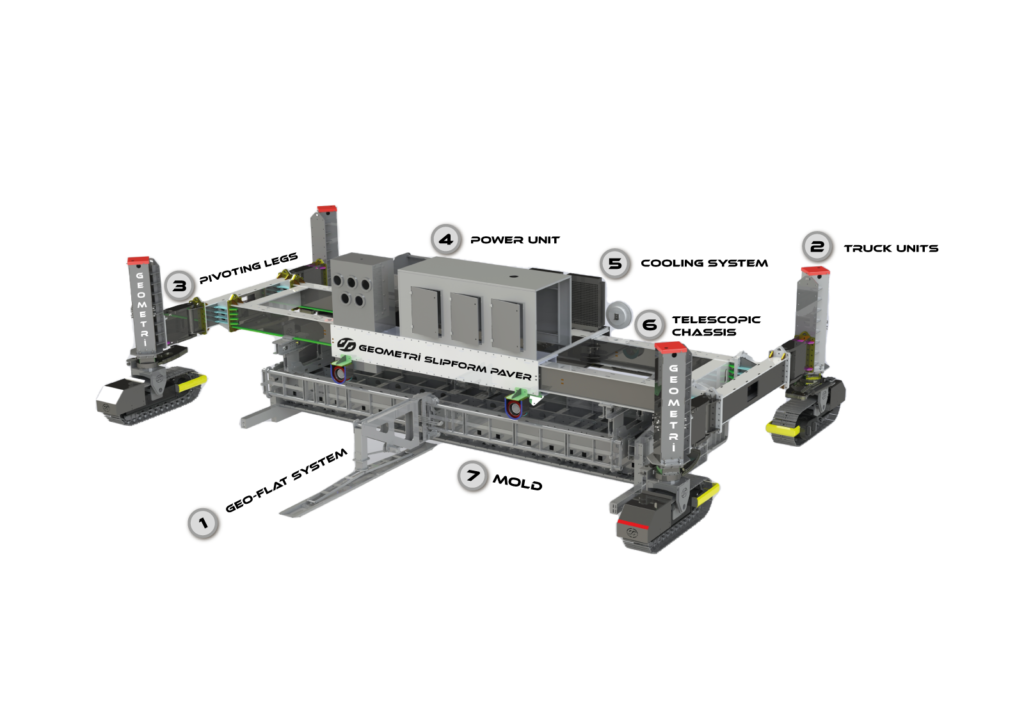

The Most Profitable in its Sector

EU Stage 3 /
US EPA Tier 3f

1000-6000
mm

0-450
mm
Geometri Slipform Pavers deliver fast, smooth, and durable concrete paving for roads, runways, and highways — precision-engineered for superior performance.
Geometri Slipform Pavers – Precision. Power. Performance.
Engineered for Efficient and Cost-Effective Concrete Paving
GEOMETRI Slipform Pavers are designed to deliver high-speed, accurate, and cost-efficient concrete paving for major infrastructure projects worldwide.
From highways, ports, and airports to urban roads, container yards, and railway routes, our machines ensure superior smoothness, long-term durability, and fast project completion.
Available in working widths from 1.0 m to 6.0 m, GEOMETRI slipform pavers combine advanced automation, hydraulic precision, and custom mold solutions to meet international standards and your specific project needs.
Our inset paving method ensures uniform concrete distribution and optimal compaction:
Concrete is placed directly in front or from the side using a belt conveyor or side feeder.
A spreading auger or plug system evenly spreads the material across the full width.
Built-in hydraulic vibrators compact the concrete for perfect density and finish.
A pre-concrete alignment system maintains the correct concrete level inside the mold.
The tamper-bar system refines the surface and eliminates trapped air or large particles.
Optional systems such as dowel bar inserters, side or middle tie bars, and the GEO-FLAT cross trowel screed ensure consistent paving quality and compliance with all modern road construction standards.
Achieve Perfect Smoothness for a Superior Driving Experience
The GEO-FLAT System is designed for ultimate surface precision.
Key features include:
A rigid, twist-free main frame for stable paving under varying material conditions.
A heavy-duty trowel screed that ensures level and even concrete surfaces.
A longitudinal smoother made from premium alloy, providing a flawless final finish with controlled back-and-forth movement.
Adjustable pressure control according to concrete consistency for optimal flatness.
Advanced Hydraulic and Automation Features
Fully Automatic Vibrator Positioning
Operators can easily adjust vibrator height and angle hydraulically via the control panel — ensuring consistent compaction and paving uniformity.
The hydraulically extendable chassis enables quick adaptation to different paving widths. It allows the machine to operate efficiently in narrow or variable-width roads — saving time without compromising quality.
Equipped with state-of-the-art sensors and a full automation system, GEOMETRI slipform pavers simplify operation to a single Start/Stop command.
Automatic control continuously adjusts:
Steering
Level and slope
Elevation
Paving alignment
Adjustable forward and reverse speeds enhance precision and operator safety during operation.


Exhaust emissions category
EU Stage 3 / US Tier 3
Number of track units
4
Paving width
1000 – 6000 mm
Layer thickness
0 – 450 mm
Paving speed
0 – 12 m/min.
Travel speed
0 – 25 m/min.
Displacement
6 I
Machine weight
26000 – 42000 kg
Mechanical height adjustment
900 mm
Rated power
194 kW / 260 HP
Hydraulic height adjustment
900 mm
The GSP60-X4 is engineered for a wide variety of concrete paving applications, delivering exceptional strength, geometry control, and surface quality in every scenario.
Precision in slope and thickness ensures perfectly leveled runways ready to handle heavy aircraft loads. The GSP60-X4 maintains flawless surface smoothness, integrates load-transfer joints, and allows custom texturing for anti-skid safety.
Ideal for high-load parking zones and maintenance hangars where resistance to fuel, oil, and mechanical stress is essential. The system enables drainage points, reinforced slab areas, and long-term durability with minimal cracking.
Handles concentrated loads from cranes, trailers, and heavy equipment. The GSP80-X4 produces high-density, uniformly compacted concrete with integrated expansion joints for heavy-duty logistics and port operations.
Perfect for rigid pavement on truck lanes and industrial roads. The machine ensures uniform slab thickness, precise edge control, and reduced joint frequency — extending pavement lifespan and cutting maintenance costs.
Ideal for regional connections and suburban infrastructure. The GSP120-X4 enables fast, continuous paving with accurate alignment and integrated drainage solutions, providing a durable, long-lasting roadway surface.
Ensures smooth grading, proper water drainage, and durable finishing. Adaptable molds allow creating curbs, parking stops, and textured pedestrian zones in one pass.
Creates safe, even surfaces with anti-slip finishing and smooth gradients. Suitable for urban cycling paths or light transport routes, combining durability with visual appeal.
Thanks to modular molds, the GSP60-X4 can form edges, shoulders, ducts, and utility channels, adapting perfectly to unique design requirements or integrated civil systems.
Airport runways are one of the most important elements of aviation infrastructure and are usually constructed using materials such as concrete or asphalt. Concrete runways are preferred at large airports due to their longevity and durability. For example, the runways of some major airports, such as Istanbul New Airport, are designed to have a high load capacity and are built using concrete. The surfaces of concrete runways are also provided with additional safety measures, such as transverse grooves to allow water to drain away, preventing slipping on wet surfaces. Asphalt runways are a shorter-lived alternative and are generally used at smaller airports. Both types of runways must provide a high level of straightness and good frictional behavior for safe landing and take-off of aircraft. The design and construction of airport runways is vital for aviation safety and requires specialized engineering knowledge.
Concrete highways are the preferred road construction material worldwide for their durability and longevity. The durability and low maintenance requirements of concrete make it an economical choice, especially for roads with high traffic loads. The history of concrete roads begins with the construction of Court Avenue in Ohio, USA in 1891. Today, approximately 47% of concrete roads are used in the USA, 40% in Belgium and 38% in Germany. In Turkey, the concrete road used on the road to the NATO radar base in Sinop in 1953 has been in service for more than 68 years without requiring maintenance. Concrete roads offer an environmentally friendly solution by saving 0.45 liters of fuel and reducing 1.2 kg of CO2 emissions per 100 kilometers. They also have additional advantages such as fire safety and increased visibility at night. For these reasons, concrete highways are an important infrastructure option in terms of both cost effectiveness and environmental sustainability.

The use of concrete roads offers significant environmental and economic advantages. Thanks to their rigid structure, concrete roads provide economic savings by reducing fuel consumption by an average of 0.45 liters per 100 kilometers. They require low maintenance over a long service life and have lower life cycle costs than alternative roads. Furthermore, within the framework of sustainable construction, the production and use of concrete roads promotes the efficient use of natural resources and increases respect for the environment. In this context, concrete roads are a sustainable solution for society and meet the key criteria of environment, economy and society.
